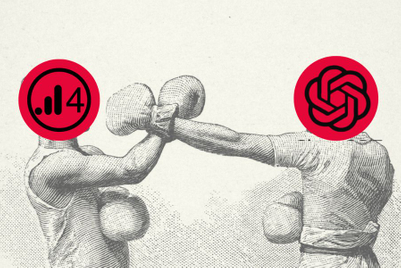
Much has been written about how AI will change the practice of PR, from faster and deeper insights to zero cost of content production. But we’re only starting to hear brands expressing concern about what may be AI’s highest potential for impact on public relations, and that’s the potential for change in human behaviour. AI could fundamentally transform the way people experience media, news, information, content and brands.
The shift to AI as an arbiter of brand reputation is underway, with many people choosing “answer engine” apps like Perplexity over Google Search. Soon, these answer engines and personal assistant AIs will appear not only in our web browsers and phones but also in our homes, cars, and even on our faces.
As answer engine use grows toward critical mass, AI may soon be the first place your audiences turn to answer questions about your category, brand, company and executives. Your target customers will ask AI for recommendations on products and services like yours and your competitors. What AI systems say about your brand matters.
The potential for reputation impact is wider than B2C brands. In a February Pew Research study, 20% of employed Americans said they’ve used ChatGPT for work tasks, up nearly two-fold from July. Soon, AI assistants at work may simplify the B2B buyer decision journey from a complicated mess of a flowchart to “Ask. Answer. Buy.”
To protect and strengthen brand reputation in an AI world, corporate and brand communications leaders need to start monitoring and influencing AI-powered answer engines and the large language models that underpin them.
Monitoring brand reputation in AI
As management legend Peter Drucker said, “If you can’t measure it, you can’t manage it.” Communicators need tools for monitoring brand-relevant keywords across answer engines at the core of the public relations tech stack, alongside tools for monitoring earned media and social media.
Adapting best practices from tracking earned and social media, communicators should monitor AI answer engines from all major providers not only for the brand name but also the company’s products, services, executives and competitors, along with relevant category keywords—accuracy and positivity in AI responses to queries about your brand fuel consideration for your products and services. Your brand’s inclusion in AI responses to category-level questions generates awareness and competitive advantage.
Answer engine monitoring's outputs enable communicators to set meaningful objectives for improving AI reputation and track progress against those objectives over time.
Managing brand reputation in AI
Like brand reputation in earned and social media, reputation in AI cannot be bought. Answer engines and LLMs cannot be edited. Reputation must be earned through influence, making AI reputation management the next frontier in public relations.
Because answer engines and their underlying LLMs are fed largely by crawling the public internet, brands should manage their reputation on the internet more intentionally than ever to positively influence AI answer engines.
Earned media features prominently in LLM training just as it does with Search Engine Optimization, and companies such as Apple are actively exploring deals with news publishers to license articles to train their models. One of the biggest issues with LLMs is that they represent a static view of the world when they are taught. This is changing quickly, as answer engines like Microsoft Copilot and Perplexity have incorporated real-time news into responses, while Elon Musk’s Grok AI leverages real-time data from X.
Owned media like brand websites, newsrooms, investor centres and blogs all feed LLMs, including those with real-time capabilities like Microsoft Copilot. Google’s EEAT principles — experience, expertise, authoritativeness and trustworthiness — apply to optimising owned media for LLMs the same way they do for search engine optimisation. A November 2023 academic study on “generative engine optimisation” or GEO—like SEO, sometimes also called “generative AI optimisation” GAIO or “LLM optimisation” LLMO — suggests three actions to improve brand impressions in LLM responses by 30% on average: adding relevant statistics, incorporating quotes from recognised experts and citing reliable sources. Every communicator should take a fresh look at their corporate newsroom, blog, investor centre and website through the lens of “What questions am I answering that an LLM might pick up and use?”
Social media also influences LLMs significantly, making it imperative for brands to activate individual executives, subject matter experts and thought leaders to participate in relevant social media discussions scraped by LLMs for training data. A prime example of a social media opportunity is Reddit. We already know the shortcut to finding authoritative, expert, experienced and trusted content on the internet is to take your Google search and append the word “Reddit” to it. That’s probably why Google spends $60 million annually to license Reddit’s content to train its AI models. Beyond activating employees, brands can shape LLMs by turning stakeholders into advocates, from individual customers and brand fans to third-party experts and trusted influencers.
Wikipedia engagement has long been a risky proposition for brands, but because Wikipedia is a prime source for LLM training data, now’s a good time for communicators to take a fresh look at how their brand shows up on the platform. They should also take action by engaging editors through the Talk pages of relevant articles, following the Wikipedia plain and simple conflict of interest guide.
Programmatic approaches based on ML concepts like in-context learning and reinforcement learning from human feedback are complementing and enhancing the other four strategies for influencing LLMs on behalf of brands. Massive innovations will come to market through this year's end and next.
Brian Snyder is the global president of digital at Axicom.




.jpg&h=334&w=500&q=100&v=20250320&c=1)


.jpg&h=334&w=500&q=100&v=20250320&c=1)




+(900+x+600+px)+(3).png&h=334&w=500&q=100&v=20250320&c=1)





.jpg&h=268&w=401&q=100&v=20250320&c=1)

.png&h=268&w=401&q=100&v=20250320&c=1)